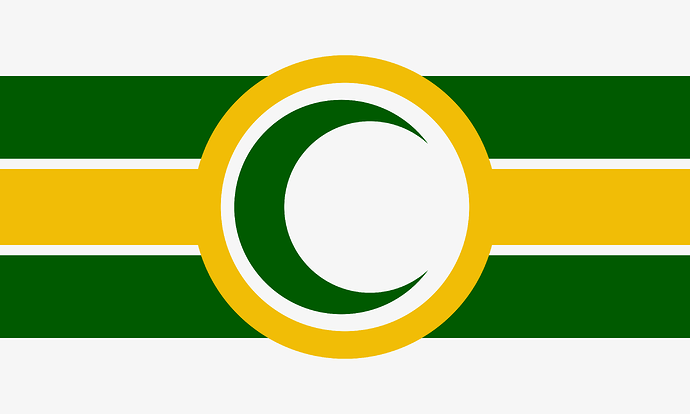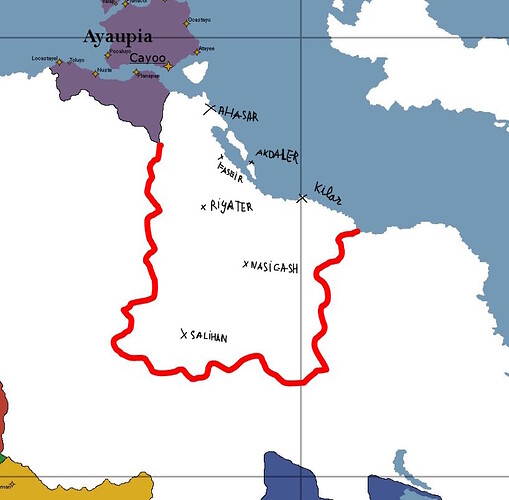Basic National Facts
Flag:
Nation Name (long): Coalition State of the Marishan Kolun
Nation Name (short): The Coalition State, or Marisha.
Motto: (non-official)
National Animal: Marishan Fennec Fox (in accordance to Kol Tasha’s premiership of the Coalition State)
National Flower/Plant: Laxmi Lotus (unofficial, often affiliated with Kol Tasha)
National Anthem: N/A, no anthem on a national level, though individual kolun may have their hymns and traditional chants.
Capitol: Kilar Kilar Neutral Gathering Zone.
Largest City: Kilar Neutral Gathering Zone.
Demonym: Officially Marishan, though citizens often refer to themselves by the denonym of their birth kol.
Language(s): working language is officially registered as Standard Marishan, however, due the prominence of various kolun, local dialects of the language are commonly spoken amongst friends and families, along with Fefsen as a lingua franca.
Species: 86% humans, 13% elven, 1% others/
Population: 33,423,114
Government type: Confederation.
Leader(s): Berhevdar Tasha
Legislature: Grand Assembly of the Kolun.
Formation: April 4, 1923.
Total GDP: 673,321,424,865 SHD.
It should be noted that the decentralised nature of the Coalition State has impeded accurate calculation of the economy’s size and scale, with official figures used being provided by the Coalition State Exchequer Union, the source data having been provided by individual kolun.
GDP per capita: 20,145 SHD
Calling Code: 3-digit code.
ISO 3166 code: CSM, CS
Internet TLD: .cs
Historical Summary:
A society organised around loose family groupings, many of which now include hundreds of thousands of members, the Coalition State is an artificial organisation that transcend the borders of individual groups with the goal of facilitating trade, economic development and defence. These extended family groupings, referred to in many local languages as a “kol” (plural form: kolun), vary in origins and ethnic backgrounds and many settled in the region in different periods in history, though most archeologists agree that the first trace of civilisation in the region appear around 600 BCE with the Dharut culture believed to have been related to the southern Ashurian Kingdom.
Unlike their neighbours, civilisation developed following a different course, reflecting both the unique natural conditions and demographic distribution of the region. As such, combined with the tendency of its people to remain in the community of their births, a multitude of city states focused around artisanal crafts and trade, as well as feudal kingdoms and nomadic communities emerged, never a unified state. Oftentimes, these city states, feudal kingdoms and groups of nomads consist of a singular ruling kol through either blood or association.
With their relative geographic isolation from eyeing empires to the South, with its rich coasts having been separated from them by a rolling deserts, the kolun of the region were allowed to develop. Despite this, competition for resource was fierce, as the seasonal movements of kolun led to frequent clashes, exacerbated by the frequent arrival of new groups to the region. Thus, combined with minimal influence from outside forces, society continued to develop around individual koluns well into the modern era.
With the arrival of new colonial powers in the region, from the 19th century to the 20th as well as the rapid advancement of technology following the global industrial revolution, the region’s relative isolation was at risk. The disastrous defeat of Kol Akdaler, and the signing of the Convention of Kilar in 1922, along with the rapid defeat of Mukarras the South sparked a political crisis amongst the kolun.
In the aftermath, in a signing of a convention led forward by Kol Tasha, supported by the dire situation at hand saw the the formation of the Coalition State of the Marishan Kolun, as proclaimed on 4 April, 1924 based on the Karzanan capital of Kalir. Though conflicts more often than not erupt between the kolun, the state-building efforts garnered much success as the nation successfully avoided the fate of protectorate or colony.
However, as radical changes in the region came in the wake of the new decade, the Kolun once again found itself in a political crisis unprecendented since the beginning of the previous century. Whether the Coalition State will persevere, or be doomed to lay low has yet to be seen.
Map:

